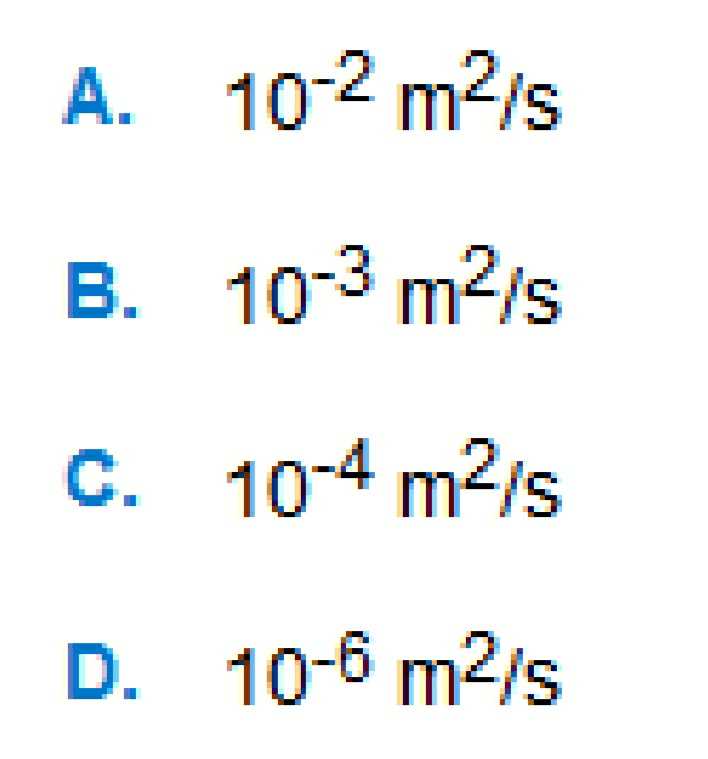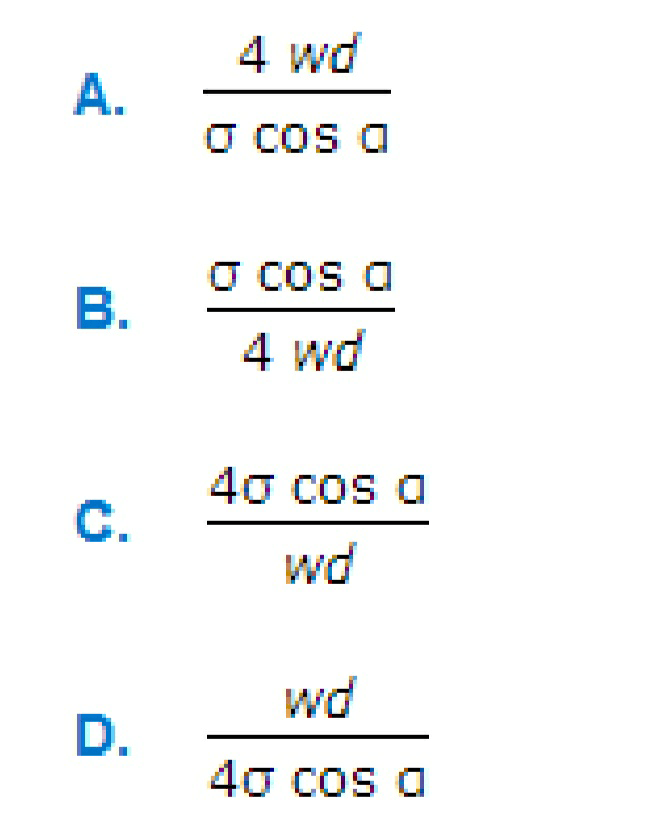MCQ OF FLUID MECHANICS AND HYDRAULICS SUBJECT
MODULE 1: PROPERTIES OF FLUIDS
1. One litre of water occupies a volume of
A. 100 cm3
B. 250 cm3
C. 500 cm3
D. 1000 cm3
Answer: Option D
2. The kinematic viscosity is the
A. ratio of absolute viscosity to the density of the liquid
B. ratio of density of the liquid to the absolute viscosity
C. product of absolute viscosity and density of the liquid
D. product of absolute viscosity and mass of the liquid
Answer: Option A
3. When a tube of smaller diameter is dipped in water, the water rises in the tube due to viscosity of water.
A. True
B. False
Answer: Option B
4. The pressure less than atmospheric pressure is known as
A. suction pressure
B. vacuum pressure
C. negative gauge pressure
D. all of these
Answer: Option D
5. The coefficient of viscosity may be determined by
A. capillary tube method
B. orifice type viscometer
C. rotating cylinder method
D. all of these
Answer: Option D
6. The weight per unit volume of a liquid at a standard temperature and pressure is called
A. specific weight
B. mass density
C. specific gravity
D. none of these
Answer: Option A
7. The atmospheric pressure at sea level is
A. 103 kN/m2
B. 10.3 m of water
C. 760 mm of mercury
D. all of these
Answer: Option D
8. When the pressure intensity at a point is less than the local atmospheric pressure, then the
difference of these two pressures is called vacuum pressure.
A. Agree
B. Disagree
Answer: Option A
9. The unit of dynamic viscosity in S.I. units is
A. N-m/s2
B. N-s/m2
C. poise
D. stoke
Answer: Option B
10. The specific gravity has no units.
A. Agree
B. Disagree
Answer: Option A
11. A glass tube of smaller diameter is used while performing an experiment for the capillary rise of water because
A. it is easier to see through the glass tube
B. glass tube is cheaper than a metallic tube
C. it is not possible to conduct this experiment with any other tube
D. all of the above
Answer: Option A
12. The viscosity of a liquid is due to cohesion of its particles.
A. Correct
B. Incorrect
Answer: Option A
13. The viscosity of water is __________ than that of mercury.
A. higher
B. lower
Answer: Option A
14. The Newton’s law of resistance is based on the assumption that the
A. planes of the body are completely smooth
B. space around the body is completely filled with the fluid
C. fluid particles do not exert any influence on one another
D. all of the above
Answer: Option D
15. The volume per unit mass of a liquid is called specific volume.
A. Yes
B. No
Answer: Option A
16. The unit of dynamic viscosity in S.I. units is
A. N-m/s2
B. N-s/m2
C. poise
D. stoke
Answer: Option B
17. The density of air is same at different heights.
A. Correct.
B. Incorrect
Answer: Option B
18. The Newton’s law of resistance is based on the assumption that the
A. planes of the body are completely smooth
B. space around the body is completely filled with the fluid
C. fluid particles do not exert any influence on one another
D. all of the above
Answer: Option D
19. Water is __________ liquid.
A. a compressible
B. an incompressible
Answer: Option B
20. With an increase in size of tube, the rise or depression of liquid in the tube due to surface tension will
A. decrease
B. increase
C. remain unchanged
D. depend upon the characteristics of liquid
Answer: Option A
21. One stoke is equal to
Answer: Option C
22. The specific weight of water in S.I. units is taken as
A. 9.81 kN/m3
B. 9.81 x 103 kN/m3
C. 9.81 x 10-6 N/mm3
D. any one of these
Answer: Option A
23. The specific weight of sea water is __________ that of pure water.
A. same as
B. less than
C. more than
Answer: Option C
24. The force exerted by a moving fluid on an immersed body is directly proportional to the rate of change of momentum due to the presence of the body. This statement is called
A. Newton’s law of motion
B. Newton’s law of cooling
C. Newton’s law of viscosity
D. Newton’s law of resistance
Answer: Option D
25. Stoke is the unit of
A. kinematic viscosity in C. G. S. units
B. kinematic viscosity in M. K. S. units
C. dynamic viscosity in M. K. S. units
D. dynamic viscosity in S. I. units
Answer: Option A
26. The absolute pressure is equal to
A. gauge pressure + atmospheric pressure
B. gauge pressure – atmospheric pressure
C. atmospheric pressure – gauge pressure
D. gauge pressure – vacuum pressure
Answer: Option A
27. When the pressure intensity at a point is more than the local atmospheric pressure, then the difference of these two pressures is called
A. gauge pressure
B. absolute pressure
C. positive gauge pressure
D. vacuum pressure
Answer: Option C
28. Gauge pressure at a point is equal to the absolute pressure __________ the atmospheric pressure.
A. plus
B. minus
Answer: Option B
29. The vacuum pressure is always the negative gauge pressure.
A. Yes
B. No
Answer: Option A
30. A fluid whose viscosity does not change with the rate of deformation or shear strain is known as
A. real fluid
B. ideal fluid
C. newtonian fluid
D. non-newtonian fluid
Answer: Option C
31. The pressure measured with the help of a pressure gauge is called
A. atmospheric pressure
B. gauge pressure
C. absolute pressure
D. mean pressure
Answer: Option B
32. A glass tube of small diameter (d) is dipped in fluid. The height of rise or fall in the tube given by
(where w = Specific weight of liquid, α = Angle of contact of the liquid surface, and σ = Surface tension)
Answer: Option C
33. The volume of a fluid __________ as the pressure increases.
A. remains same
B. decreases
C. increases
Answer: Option B
34. Water is a __________ fluid.
A. real
B. ideal
C. newtonian
D. non-newtonian
Answer: Option C
35. Barometer is used to measure
A. velocity of liquid
B. atmospheric pressure
C. pressure in pipes and channels
D. difference of pressure between two points in a pipe
Answer: Option B
36. The dynamic viscosity of the liquid __________ with rise in temperature.
A. remain unaffected
B. increases
C. decreases
Answer: Option C
37. The property of a liquid which controls its rate of flow is called viscosity.
A. True
B. False
Answer: Option A
38. Falling drops of water become spheres due to the property of
A. surface tension of water
B. compressibility of water
C. capillarity of water
D. viscosity of water
Answer: Option A
39. The height of a water column equivalent to a pressure of 0.15 MPa is
A. 15.3 m
B. 25.3 m
C. 35.3 m
D. 45.3 m
Answer: Option A
40. A differential manometer is used to measure
A. atmospheric pressure
B. pressure in pipes and channels
C. pressure in venturimeter
D. difference of pressures between two points in a pipe
Answer: Option D


